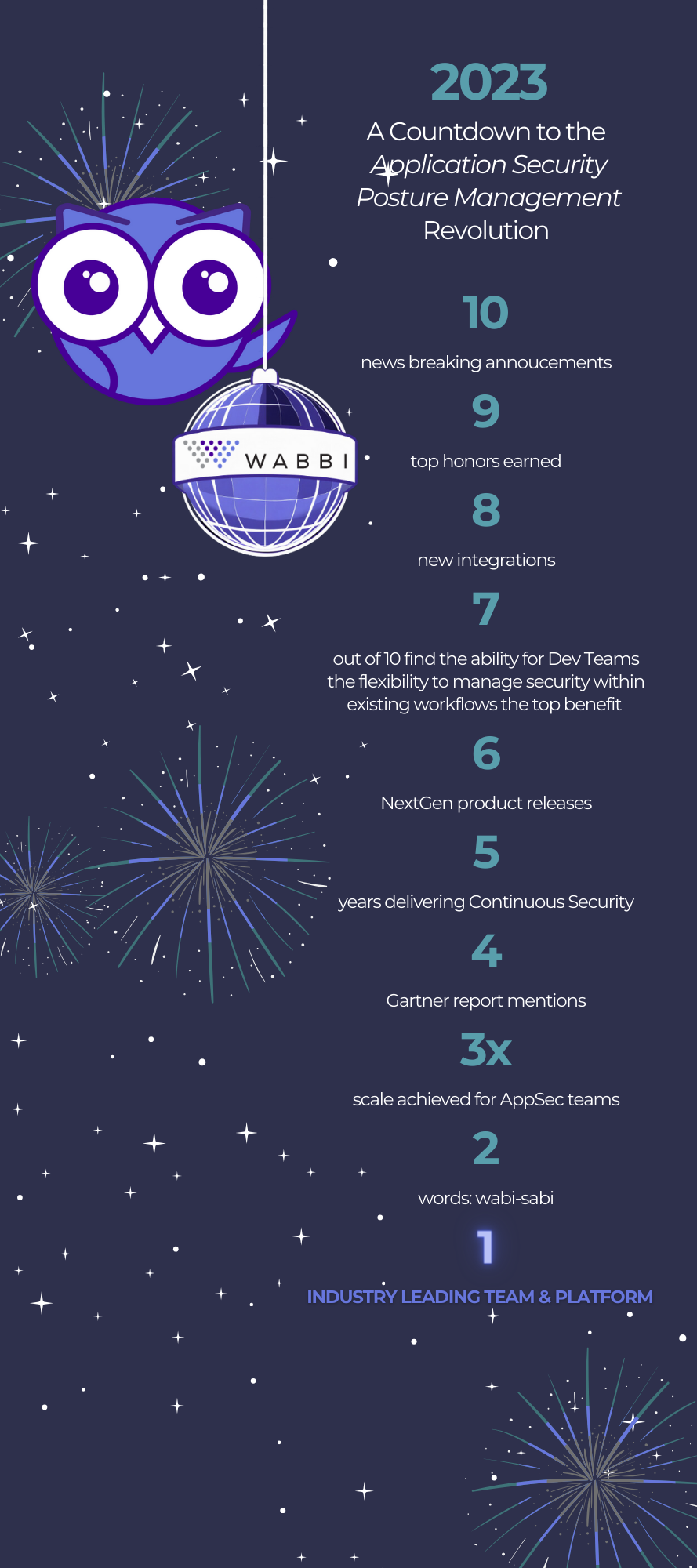January 3, 2024
2023 solidified Wabbi’s position as not just a trailblazer, but a leader in the ASPM domain, as we continued to deliver on our mission to simplify the integration of security into the software development lifecycle so organizations can realize the promise of DevSecOps.
10 News Breaking Announcements! Stay on top of them in our Newsroom
9 Top Honors Earned: Whether recognized by Analysts, Press, Industry, or Peers, we’re honored to have our platform recognized as the industry leading ASPM platform…and our CEO & Founder Brittany Greenfield was even named 40 under 40!
8 New Integrations Launched
6 Next Gen Product Releases: Wabbi was upping the ASPM game by introducing the Next Gen of our core functionality and new modules as well throughout the year. From Secrets Management to Vulnerability Management and New Dashboards.
5 Years delivering Continuous Security. Remember Baby Wabbi? *sniff, sniff*
4 Gartner Reports highlighted ASPM as a transformational technology with Wabbi mentioned as a vendor, highlighting that ASPM is not just important to AppSec & DevSecOps, but also for IT Management Intelligence.
3x Scale Achieved for AppSec teams
2 Words That Define Us: Wabi-Sabi. You know the story behind our name…Have you met our newest team member – Sabi?
1 Industry Leading Team & Platform: None of this would be possible without our team, and consider us biased, but they’re the best. And we’re especially excited to add Phil as our CTO to usher in the next generation of ASPM.
But as we counted down to 2024, reflecting on the successes of 2023, what we really got us excited for was seeing how our successes in 2023 reflected that 2024 is going to be the year of ASPM.
So here is our countup for 10 things we’re excited about for ASPM in 2024:
1. Rapid adoption: Organizations have stopped planning for ASPM, and are now executing on it as a top priority, with Gartner forecasting adoption of ASPM to grow from 5% in 2023 to 40% in 2026. This is driven not only by increasing regulatory and reporting requirements and exponentially increasing volume of vulnerabilities, but also by the completion of DevOps transformations and an evolution into Platform Engineering.
- The Paradigm Shift in Software Security: As a proactive approach that empowers developers to own security as part of their existing workflows, ASPM alleviates the burden on security and development teams to expedite the delivery of secure applications. Furthermore, ASPM seamlessly integrates with existing DevSecOps tools and processes, enabling organizations to adopt it without significant disruptions. This integration ensures that security testing becomes an integral part of the development workflow, without hindering productivity or introducing additional complexities.
3. Convergence of Application & Infrastructure Security: As organizations adopt more cloud-native applications and services, the traditional boundaries between applications and infrastructure are becoming increasingly blurred. This creates new challenges for security teams, as they need to secure both the applications themselves and the underlying infrastructure, and where ASPM serves as the bridge between the two.
- Realizing the Promise of DevSecOps: Nobody is debating the relevance of integrating security into DevOps anymore, however, most organizations have failed to actually achieve the promise of DevSecOps because they have not had the backbone to actually deploy security into the SDLC. ASPM is that backbone, automating and orchestrating the AppSec processes as part of existing Development workflows.
- ASPM = AppSec SRE: ASPM is not reinventing the wheel on how organizations automate, orchestrate, and monitor processes to improve collaboration, efficiency, & productivity. Why should it? SRE has been well proven, and ASPM is extending that to the security side of the development equation. Through an SRE based approach, DevSecOps stops being a philosophy and starts focusing on the actual implementation of security in the software development lifecycle without introducing friction.
- Velocity AND Security (not OR): In the rapidly evolving landscape of application security, organizations constantly seek ways to maintain balance between velocity and security. ASPM offers enables enterprises to achieve both simultaneously. ASPM ensures that neither team’s processes are disrupted, so that Development gets the autonomy they need to develop products, and Security gets the accountability to know their processes have been followed (even when they haven’t).
- Risk-Management-by-Design: One of the universal truths is that time and money are constrained, so as organizations realize that they cannot fix everything (and software is not perfect), ASPM will enable them to automate and orchestrate their risk profile to ensure they get the most value for their efforts as they “answer” the question: What am I willing to accept, and how do control for it?
- The Death of Only Vulnerability Management: Vulnerability Management is only one part of an Application Security program, and without context, a VM solution – even an RBVM one – can only provide so much value. This is where ASPM gets to manage the all components of an Application Security program which is more than just testing. Application Security spans from secure coding to testing to monitoring and beyond, so it’s no wonder that organizations are realizing that a VM solution can’t actually get them to the promised land.
- The Application Security Lifecycle: We’ve said that AppSec has been the black sheep of the security family, and that’s because it looks a little more like Development sometimes. And of course it does – how can you secure something if you don’t align with its processes. This is where ASPM doesn’t just automate and orchestrate the AppSec processes, but manages the full lifecycle of everywhere AppSec needs to be.
- Bridging the Gap Between Security & Development: By providing a shared platform, ASPMs enable developers and security teams to work together more closely, fostering a shared understanding of security responsibilities. This collaboration helps break down silos and ensures that security is considered integral to the development process, not as an add-on.
